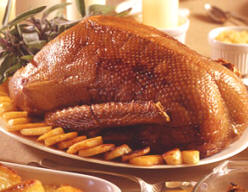In Season in Winter: Goose
Go to:Â
Main Winter Seasonal Page
Â
Jump to:-Â Â Â Â Buying
& StoringÂ
Goose | Â
Preparing and cooking Goose | Â
Editor's
Choice Top 3Â Autumn Goose Recipes
Â
Â

Â
Once the bird of choice
at Christmas in the UK , for many years goose took a back seat to
turkey. However it is making a comeback, not only for roasting whole, but
also served in individual breast or leg portions when it can been
cooked and served in a similar way to wild duck.
Â
Although you can buy frozen Goose throughout the year, in the UK fresh
goose is traditionally in season and at its best from October
to January having been fattened up for Christmas.
Â
 Â
Buying and storing fresh
Goose
Â
Fresh geese aren't always easy to come by and are often only available from
specialist suppliers or quality butchers so if you have your heart set on one,Â
you would be best to pre-order it, especially around Christmas time. As geese
have a much higher proportion of bone to flesh than other poultry, when buying
whole birds, allow 675g/1�lb per person. As smaller birds are the most
tender, if you have many people to serve it is better to get two smaller birds
rather than one large one. Choose plump-looking free-range birds.
Oven ready birds should be kept in the refrigerator and will last for a few
days. Make sure you remove the giblets and store them separately.
Â
Preparing and
Cooking fresh Goose
Â
The flesh of goose is quite dark in colour and quite rich in flavour. As
mentioned above, the younger the bird, the more tender it will be so smaller
birds are suitable for cutting into portions and pan frying.
Â
For whole birds, remove any excess fat from the cavity and set aside for
roasting potatoes or other veggies. Rinse the goose under cold running water
both inside and out and pat dry. Goose is a naturally fatty bird so the
skin needs to be pricked all over with a fork to enable the fat to be released
during cooking.Â
Â
Season the skin with salt and pepper, place breast side up on a rack in a
roasting pan. Roast at 220C, for 30 minutes then reduce to 180C, 350F, Gas
Mark 4 and roast for
25 minutes per 450g/1lbÂ
basting every 20 to 30 minutes. Pour off the fat that accumulates in the pan at
regular intervals or it will smoke. This fat is worth its weight in gold and can
be stored in the fridge for a few days, or frozen. It adds a fantastic
flavour to roast potatoes and other veggies and can be used to fry or confit. If
parts of the goose seem to be browning too quickly, wrap them in foil.
The goose is cooked when a skewer in the thickest part of the thigh reveals
clear juices although the flesh may still be slightly pink. Remove from the
oven, cover with foil and rest for 15 minutes before carving.
Â
Â
Editor's Choice:Â Top 3
Winter
Season Goose Recipes
 |